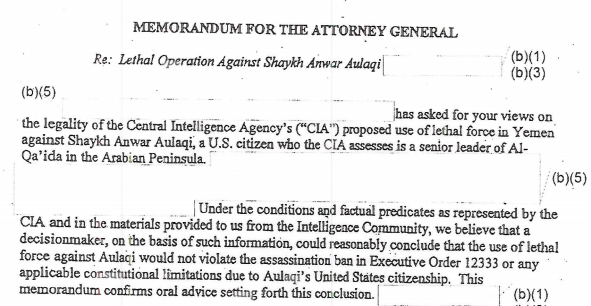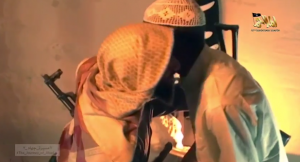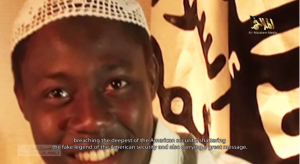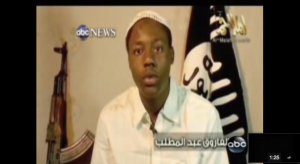As a number of people have noted (Jen Daskal is one), the OLC memo released yesterday doesn’t describe what the government considers an imminent threat.
Meanwhile, Ben Wittes is unexpectedly spending his time writing interesting posts about why imminence is in there in the first place, and not mocking the NYT editorial calling for a drone and/or targeted killing court.
Wittes writes.
I think the source of law for imminence in Holder’s speech, in the white paper, and in this memo is a presidential covert action finding. That is, I think the president, in issuing whatever finding gave rise to the killing of Al-Aulaqi, limited the authorization to situations involving imminent threats. This invocation was prudential, not legally required by any other source of law, but it operates as law for the executive branch.
There are a few pieces of evidence—not conclusive, but suggestive—supporting this view:
The most important is that memo—by omission—excludes the other major possibilities. If the imminence requirement is not there because of constitutional separation of powers, international law, or the constitutional rights of the targets, it’s got to be coming from somewhere. Internal executive branch law is one of the few remaining possibilities.
Moreover, it’s the only obvious possibility I can think of that would leave so little footprint in the memo. Indeed, if the imminence discussion is present but redacted, that suggests that the very source of law is classified. That is consistent with its appearance in a finding. Alternatively, if the reason the discussion seems to be missing is that it isn’t there at all, that is also consistent with its originating in a finding. After all, if we assume that imminence is only a requirement because the president said it’s a requirement, it follows that the concept means—at least in this context—whatever the president wants it to mean.
I’m not sure I buy that there is no legal reason for imminence, but I do agree it is relatively absent in what we have of the July 16, 2010 memo.
As it happens, in my thinking about the absence of a discussion of imminence in this memo, I have started comparing what’s in the white paper but not the OLC memo (I have already noted that the desultory treatment of why Courts couldn’t review the assassination is not in the OLC memo).
Remember, there are two possible explanations for why something would be in the White Paper (dated November 8, 2011, over a month after Awlaki was killed) but not in the July 16, 2010 OLC memo we got yesterday. First, those missing elements could be in the first OLC memo, from February 2010. Section VI of yesterday’s memo cites from and appears to repeat the analysis from that other memo. And that’s precisely where the reference to “imminent” is.
The task before OLC in February 2010 was likely somewhat different than the task in July 2010, because not only did OLC have to come up with an argument for killing an American going forward, but it likely felt some urgency to justify the attack on Awlaki attempted on Christmas Eve 2009, which was by all reports conducted under Article II justification. Dana Priest’s report that Awlaki was on the JSOC kill list probably created real urgency in January and February to provide this justification. Both the fact that that strike was attempted under solely Presidential authority, and that it was done without prior OLC review would raise the importance of arguing that Awlaki, in the wake of early December 2009 revelations that he had been in contact with Nidal Hasan, was an imminent threat.
The other possibility is that the emphasis on imminence came after the OLC memo, and DOJ added it into the white paper either for what was intended to be public (or at least Congressional) consumption, or to deal with developments that occurred between the time David Barron finished the memo in July 2010 and the time the government killed Awlaki 14 months later.
Meanwhile, I’ve been puzzling over something that appears in the white paper that we know can’t appear in either OLC memo: the citation to John Brennan’s September 16, 2011 speech on “Strengthening our Security by Adhering to our Values and Laws.” This sentence of that speech was cited: “The United States does not view our authority to use military force against al-Qa’ida as being restricted solely to ‘hot’ battlefields like Afghanistan.” That is, unless I’m mistaken, the only reference to a source that post-dates the OLC memo that authorized Awlaki’s killing.
As it turns out, that sentence introduces a discussion that leads to a treatment of the government’s definition of “imminence.”
The United States does not view our authority to use military force against al-Qa’ida as being restricted solely to “hot” battlefields like Afghanistan. Because we are engaged in an armed conflict with al-Qa’ida, the United States takes the legal position that —in accordance with international law—we have the authority to take action against al-Qa’ida and its associated forces without doing a separate self-defense analysis each time. And as President Obama has stated on numerous occasions, we reserve the right to take unilateral action if or when other governments are unwilling or unable to take the necessary actions themselves.
That does not mean we can use military force whenever we want, wherever we want. International legal principles, including respect for a state’s sovereignty and the laws of war, impose important constraints on our ability to act unilaterally—and on the way in which we can use force—in foreign territories.
Others in the international community—including some of our closest allies and partners—take a different view of the geographic scope of the conflict, limiting it only to the “hot” battlefields. As such, they argue that, outside of these two active theatres, the United States can only act in self-defense against al-Qa’ida when they are planning, engaging in, or threatening an armed attack against U.S. interests if it amounts to an “imminent” threat.
In practice, the U.S. approach to targeting in the conflict with al-Qa’ida is far more aligned with our allies’ approach than many assume. This Administration’s counterterrorism efforts outside of Afghanistan and Iraq are focused on those individuals who are a threat to the United States, whose removal would cause a significant – even if only temporary – disruption of the plans and capabilities of al-Qa’ida and its associated forces. Practically speaking, then, the question turns principally on how you define “imminence.”
We are finding increasing recognition in the international community that a more flexible understanding of “imminence” may be appropriate when dealing with terrorist groups, in part because threats posed by non-state actors do not present themselves in the ways that evidenced imminence in more traditional conflicts. After all, al-Qa’ida does not follow a traditional command structure, wear uniforms, carry its arms openly, or mass its troops at the borders of the nations it attacks. Nonetheless, it possesses the demonstrated capability to strike with little notice and cause significant civilian or military casualties. Over time, an increasing number of our international counterterrorism partners have begun to recognize that the traditional conception of what constitutes an “imminent” attack should be broadened in light of the modern-day capabilities, techniques, and technological innovations of terrorist organizations.
At a minimum, Brennan’s speech might suggest the imminence analysis is in the OLC memos, to the extent it is, because our allies would insist on it. But even while he does that — and purportedly cedes to the international view on the battlefield that would 2 weeks later take Awlaki’s life — he suggests the definition is changing.
Remember, too, that Assassination Drone Czar Brennan would have been the one to conduct the final review of the standards laid out before okaying the killing of Awlaki, the one to decide he was still an imminent threat 21 months after he was first targeted. So Brennan’s depiction of a changing standard of imminence is quite interesting, given that either by this time, or 2 weeks later, he would have signed off on the imminence of the threat Awlaki posed.
I raise Brennan not just because I find it significant that the white paper relied on this as a “source” of authority to kill Awlaki over a year after OLC had judged it. But the reliance on the speech also suggests that the white paper emphasis on imminence might post-date both OLC’s memos on Awlaki.
And there is one obvious thing that emphasized imminence — and the potential role of judges — that post-dated the OLC memo, though not by much. Around July 1, Nasir al-Awlaki’s father retained ACLU and Center for Constitutional Rights to represent him in a challenge to Awlaki’s targeting. The very same day OLC issued its memo, Treasury named Awlaki a Special Designated Terrorist, which required the ACLU and CCR to request permission to represent Awlaki’s father to avoid being charged with material support for terrorism.
In their suit — filed August 30 — they asked for,
a declaration from this Court that the Constitution and international law prohibit the government from carrying out targeted killings outside of armed conflict except as a last resort to protect against concrete, specific, and imminent threats of death or serious physical injury; and an injunction prohibiting the targeted killing of U.S. citizen Anwar Al-Aulaqi outside this narrow context.
That is, the ACLU/CCR suit emphasizing imminence almost certainly would have raised the stakes for it, if it wasn’t already a government standard.
In September, the government moved to dismiss the suit, arguing (as they did in the white paper but not the July 2010 OLC memo) that the courts had no role in reviewing this issue…
The Judiciary is simply not equipped to manage the President and his national security advisors in their discharge of these most critical and sensitive executive functions and prescribe ex ante whether, where, or in what circumstances such decisions would be lawful. Whatever the limits of the political question doctrine, this case is at its core.
… And arguing that the courts couldn’t determine whether someone was an imminent threat.
For example, even assuming for the sake of argument that plaintiff has appropriately described the legal contours of the President’s authority to use force in a context of the sort described in the Complaint, the questions he would have the court evaluate—such as whether a threat to life or physical safety may be “concrete,” “imminent,” or “specific,” or whether there are “reasonable alternatives” to force—can only be assessed based upon military and foreign policy considerations, intelligence and other sources of sensitive information, and real-time judgments that the Judiciary is not well-suited to evaluate.
See also this post for the choose your own adventure novel the government laid out to cover Awlaki’s killing.
Whatever the government argued in February 2010, its arguments to combat this suit in September 2010 required the government to deal with imminence directly, whether or not they did extensively in February or July 2010. And then, just weeks before they killed Awlaki (it having been a year since the most recent publicly claimed attack the government claimed Awlaki had a role in), the Administration publicly advocated a very flexible notion of imminence.
Clearly, the government nodded to imminence before the Nasir al-Awlaki suit, at least by a few weeks. But certainly, the government’s successful attempt at avoiding court review relied on certain arguments that show up in more prominent form in November 2011 then it does in July 2010.
Again, I’m agnostic whether the government emphasized imminence to explain the (under the standard as written, because the government did not believe Awlaki to be operational on that day) illegal strike against Awlaki from December 24, 2009, or whether they increased their focus on imminence in response to CCR and ACLU. But I think either might be a likely explanation.





